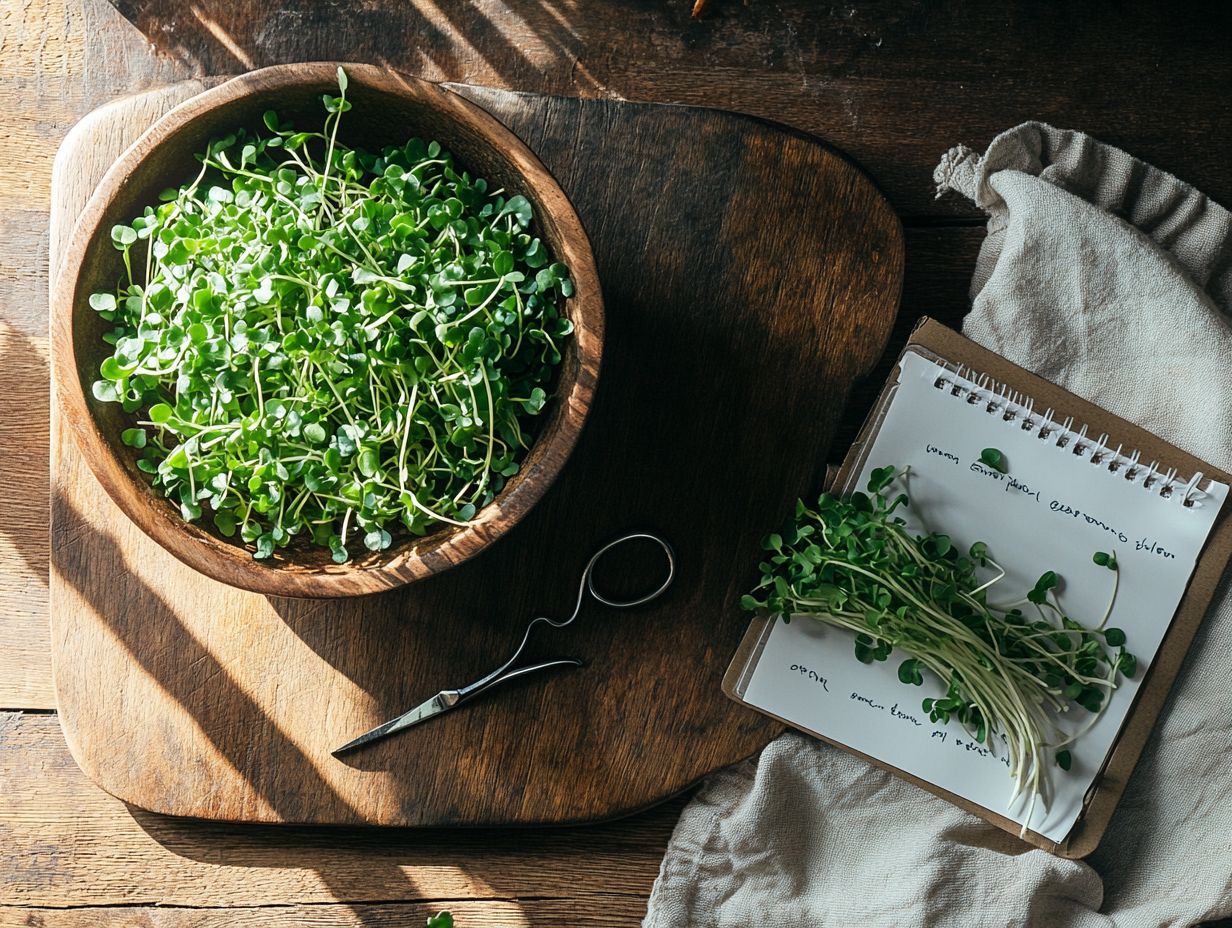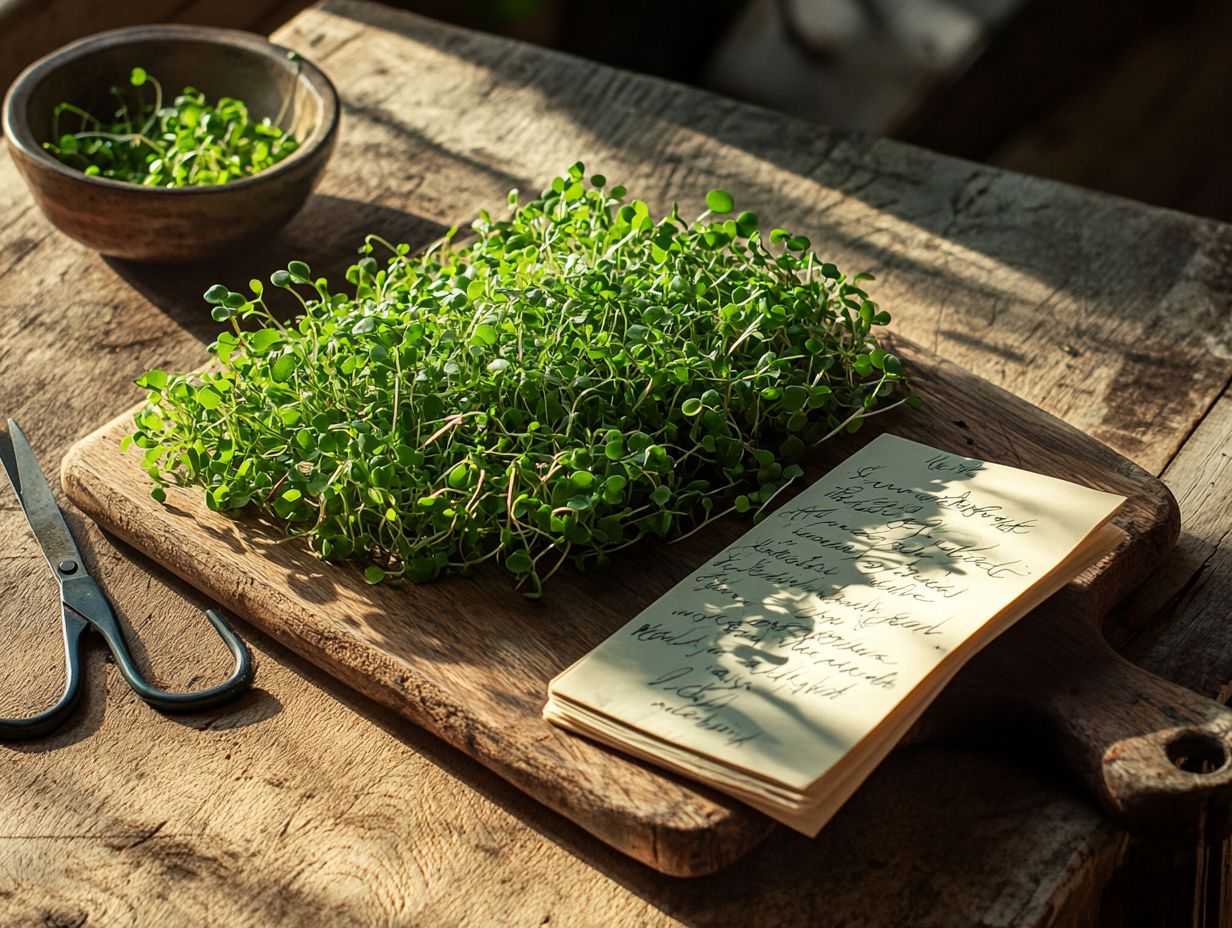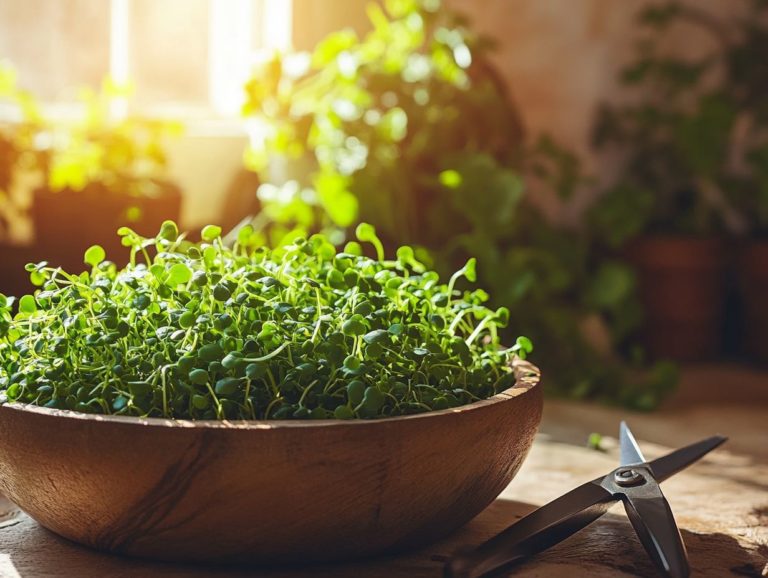How to Maintain Microgreen Quality Post-Harvest
Microgreens are delightful, tiny plants brimming with nutrients that have taken the culinary world by storm! However, the quality of these tiny powerhouses can really vary, influenced by factors like environmental conditions and harvesting techniques, especially when growing microgreens.
This article delves into the essence of microgreens, the various elements that affect their quality, and the crucial post-harvest handling practices you need to know to maintain high-quality microgreens. You’ll uncover invaluable tips for storage and transportation, ensuring your microgreens remain fresh and vibrant.
Join the journey as you discover the secrets to maximizing the shelf life of these exquisite greens, essential for the microgreens market!
Contents
- Key Takeaways:
- What are Microgreens?
- Factors Affecting Microgreen Quality
- Post-Harvest Handling of Microgreens
- Tips for Maintaining Microgreen Quality
- Frequently Asked Questions
- How do I maintain microgreen quality after harvesting them?
- Can I store microgreens in the refrigerator?
- How often should I water my microgreens after harvesting?
- Can I freeze microgreens to maintain their quality?
- Do I need to wash microgreens before storing them?
- How can I extend the shelf life of microgreens?
Key Takeaways:

- Keep microgreens fresh by storing them in a cool, dark place with proper air circulation.
- Maximize the shelf life of microgreens by harvesting at the right stage and using proper handling techniques during transportation and distribution.
- Maintain the quality of microgreens by regularly monitoring environmental factors like temperature, humidity, and light exposure throughout the post-harvest process.
What are Microgreens?
Microgreens are young, edible wonders you harvest just after the first set of real leaves appears, typically within a span of 7 to 21 days post-germination. Bursting with flavor, vibrant colors, and essential nutrients, they ve become a sought-after choice in the culinary world, particularly for gourmet dishes.
You ll find varieties such as:
- Mustard
- Arugula
- Basil
- Radish
- Chervil
- Kale
- Cilantro
Each offers unique flavors and impressive nutritional profiles. As the demand for high-quality microgreens continues to rise, more producers are embracing innovative methods like greenhouse production, hydroponics (growing plants in water without soil), and aquaponics (combining fish farming with hydroponics) to thrive in this expanding market.
Factors Affecting Microgreen Quality
The quality of your microgreens hinges on several key factors, including environmental conditions, harvesting techniques, and post-harvest handling. By managing growth parameters like light, temperature, and humidity, you can cultivate robust and flavorful microgreens, which are crucial for the production cycle.
Using specialized harvesting methods will help preserve the taste and smell of your microgreens. Paying close attention to storage temperature is equally crucial, as it can greatly influence their post-harvest quality and shelf life. Additionally, knowing how to maximize yields from microgreens can further enhance your overall success.
Environmental Factors
Environmental factors are pivotal in the growth and quality of microgreens, impacting everything from germination rates to flavor profiles. Whether you’re cultivating microgreens in a greenhouse or utilizing hydroponics and aquaponics systems, managing light, temperature, and humidity is essential. Understanding how these factors interact allows you to optimize your cultivation methods to yield higher quality microgreens that attract the market.
For instance, adequate light is crucial, as it directly influences chlorophyll production, which affects the vibrant color and taste of your microgreens, making them more appealing to restaurants. Maintaining specific humidity levels not only helps prevent diseases but also aids in nutrient absorption, ensuring your plants develop properly.
Temperature fluctuations can either accelerate or hinder growth rates. Cooler environments may lead to more tender varieties, while warmer temperatures often enhance flavor intensity, particularly in Mustard Microgreens. By tracking and adjusting these variables, you can fine-tune your practices, resulting in robust microgreens that offer superior taste and enhanced nutritional value.
Ready to grow your own microgreens? Dive into this exciting journey and explore more related articles to enhance your green thumb!
Harvesting Techniques

Harvesting techniques are essential for ensuring that your microgreens maintain their freshness and quality after harvesting. By cutting at the right height and timing your harvest correctly, you can significantly influence the flavor and nutritional content of your microgreens. Choosing the right seed selection also plays a role. Proper handling during this process minimizes damage, which is vital to keep them fresh until they reach kitchens or restaurants.
You have a range of methods at your disposal, from manual cutting to mechanical harvesting. Each method yields different results in terms of quality. Hand-harvesting is often preferred for delicate varieties since it minimizes disturbance and preserves essential oils and nutrients. In contrast, mechanical methods can offer greater efficiency but may lead to bruising if not executed carefully.
Timing your harvest is equally important. Microgreens picked just before maturity usually deliver the most robust flavor and nutritional benefits, making them a favorite among seed suppliers. After cutting, don’t underestimate the importance of prompt post-harvest handling. For those encountering issues, troubleshooting common microgreen growth issues can guide you. Swift cooling and proper storage are vital to locking in that freshness, ultimately enhancing the eating experience.
Post-Harvest Handling of Microgreens
Post-harvest handling is crucial for preserving quality and freshness of your microgreens, especially in the community-supported agriculture (CSA) market. This begins the moment they are harvested and continues until they reach your customers. Maintaining the right storage temperature keeps the crispness and flavor intact.
Use effective transportation methods to ensure that your microgreens arrive at their destination in peak condition. Attention to detail during these stages is essential for meeting the high standards demanded in the thriving microgreens market, particularly considering the importance of light quality for microgreens.
Storage and Packaging
Effective storage and packaging are crucial for extending the shelf life and maintaining the post-harvest quality of your microgreens. By using temperature-controlled environments, you can keep your microgreens fresh and flavorful. Choosing the right packaging materials is equally important, as they protect your greens from physical damage and moisture loss.
These practices are essential for meeting the rising demand in the restaurant industry and the CSA market, where fresh microgreens are highly sought after. To enhance the longevity of your delicate crops, consider implementing strategies like proper airflow and humidity control. Additionally, understanding the impact of water quality on microgreens and utilizing breathable packaging allows excess moisture to escape, thereby reducing the risk of mold and spoilage.
If you want to take it up a notch, vacuum sealing can provide an extra layer of protection, helping your microgreens maintain their vibrant colors and nutrient density. Additionally, understanding watering techniques for thriving microgreens and regularly monitoring your storage conditions and adjusting as needed can significantly contribute to maximizing freshness.
Ultimately, your commitment to quality will result in happier customers who truly appreciate the excellence of their purchases. Implement these practices today and watch your microgreens thrive!
Transportation and Distribution
Transportation and distribution of microgreens require meticulous planning to guarantee they reach their destination in peak freshness and quality.
This involves choosing the right transportation methods and carefully timing your deliveries to align with the bustling rhythms of restaurant operations. Factors like humidity levels during transit can drastically affect the texture and flavor of your microgreens. By ensuring they are packaged in airtight, breathable containers, you can prevent moisture buildup while allowing for essential airflow.
For those in the restaurant industry, understanding these logistics is crucial, as it influences everything from food presentation to taste, ultimately affecting patron satisfaction. A sharp focus on these details can cultivate strong relationships between suppliers and culinary establishments, particularly those specializing in fresh produce.
Tips for Maintaining Microgreen Quality

Maintaining the quality of microgreens is crucial for you as a producer aiming to meet the expectations of both consumers and the restaurant industry.
By implementing proper storage and handling techniques, you can minimize loss and maximize shelf life. This ensures better outcomes for producers in the microgreens business.
Strategies like temperature control, meticulous packaging, and efficient inventory management will significantly elevate the overall quality and market appeal of your microgreens.
Proper Storage and Handling Techniques
Proper storage and handling techniques are essential for ensuring that your microgreens retain their freshness and post-harvest quality using vegetable transplants.
This means maintaining optimal storage temperatures and using suitable containers to minimize physical damage. By honing in on these practices, you can enhance the marketability of your high-quality microgreens and meet consumer demand for certified organic options.
To control temperature, utilizing perforated containers allows for necessary airflow, preventing excess moisture buildup that could lead to spoilage.
Keeping your microgreens in a dark, cool environment can significantly extend their shelf life. This is a critical factor for success in the microgreens market.
It’s also crucial to regularly check humidity levels. The right humidity can help maintain crispness and nutrient density.
Implementing a first-in, first-out (FIFO), a method to use older stock first inventory system ensures that you use older stock before newer products, reducing waste and ensuring that your customers receive the freshest greens possible.
These small adjustments in handling and storage can greatly elevate the overall quality and enhance customer satisfaction.
Minimizing Loss and Maximizing Shelf Life
Minimizing loss and maximizing shelf life are essential goals for you as a microgreens producer striving to deliver the freshest products to your customers.
By applying effective storage strategies and maintaining optimal storage temperatures, you can significantly reduce spoilage and extend the viability of your microgreens.
These practices not only boost your profits but also delight your customers!
Regularly monitoring humidity levels and using airtight containers will help you create a controlled environment that protects your products.
Understanding market demand is key; it allows you to manage your inventory effectively, ensuring that you harvest and deliver the right quantities of Fresh Produce promptly.
Implementing quality assurance measures, such as conducting regular inspections and adhering to safety standards set forth by institutions like Pennsylvania State University, will further enhance your reputation as a reliable producer.
By prioritizing these strategies, you can adeptly navigate the challenges of supply chain fluctuations while maximizing profitability and maintaining the freshness that consumers expect, especially in Community Supported Agriculture (CSA), a subscription service where customers receive fresh produce regularly programs.
Frequently Asked Questions
How do I maintain microgreen quality after harvesting them?

To maintain microgreen quality after harvesting, it is important to follow proper post-harvest handling techniques. This includes keeping them in a cool and dry place, avoiding direct sunlight, and preventing them from wilting or drying out, particularly for varieties like Cilantro and Chervil.
Can I store microgreens in the refrigerator?
Yes, microgreens can be stored in the refrigerator to maintain their freshness, especially types such as Basil and Radish.
However, it is important to wrap them in a paper towel or store them in an airtight container to prevent wilting and spoilage.
Ready to grow your own microgreens? Start today and enjoy the fresh taste of homegrown greens!
How often should I water my microgreens after harvesting?
Water microgreens daily after harvesting to keep them crisp and prevent wilting. This is crucial for the young plants you grow.
However, avoid overwatering as it can lead to mold growth and spoilage.
Can I freeze microgreens to maintain their quality?
It’s not recommended to freeze microgreens, as it can affect their texture and flavor. Enjoy them fresh for the best taste!
If necessary, store them in the refrigerator for a few days to ensure varieties like Mustard Microgreens retain their unique flavor.
Do I need to wash microgreens before storing them?
Always wash microgreens before storing to remove dirt or debris from harvesting. Make sure to dry them thoroughly to prevent spoilage.
This is especially important for delicate varieties such as Cilantro and Chervil.
How can I extend the shelf life of microgreens?
To extend the shelf life of microgreens, keep them at the right temperature and humidity. Store them in an airtight container and keep moisture away to maintain freshness.
Don’t miss out on the fresh flavors of microgreens consume them quickly for the best taste!






